
Headless CMS scales and improves WPWhiteBoard’s content distribution, flexibility, and personalization
Mayuri Maokar
If you're building a website or any kind of digital product today, you've almost certainly heard the term "headless CMS". By separating your content from the presentation layer, you gain the freedom to create faster, more secure, and infinitely more flexible user experiences.
In this booming field, two names consistently rise to the top: Prismic and Contentful. Choosing between them, however, is more than just a technical decision; it's a strategic one that will impact how your marketing and development teams work together for years to come.
The choice isn't just about features, but about finding the philosophy that best matches your own.
To make an informed decision between Prismic and Contentful, it’s crucial to look beyond a surface-level feature comparison.
We need to examine the core philosophies that guide their design, as these platforms are built to serve fundamentally different users and operational goals.
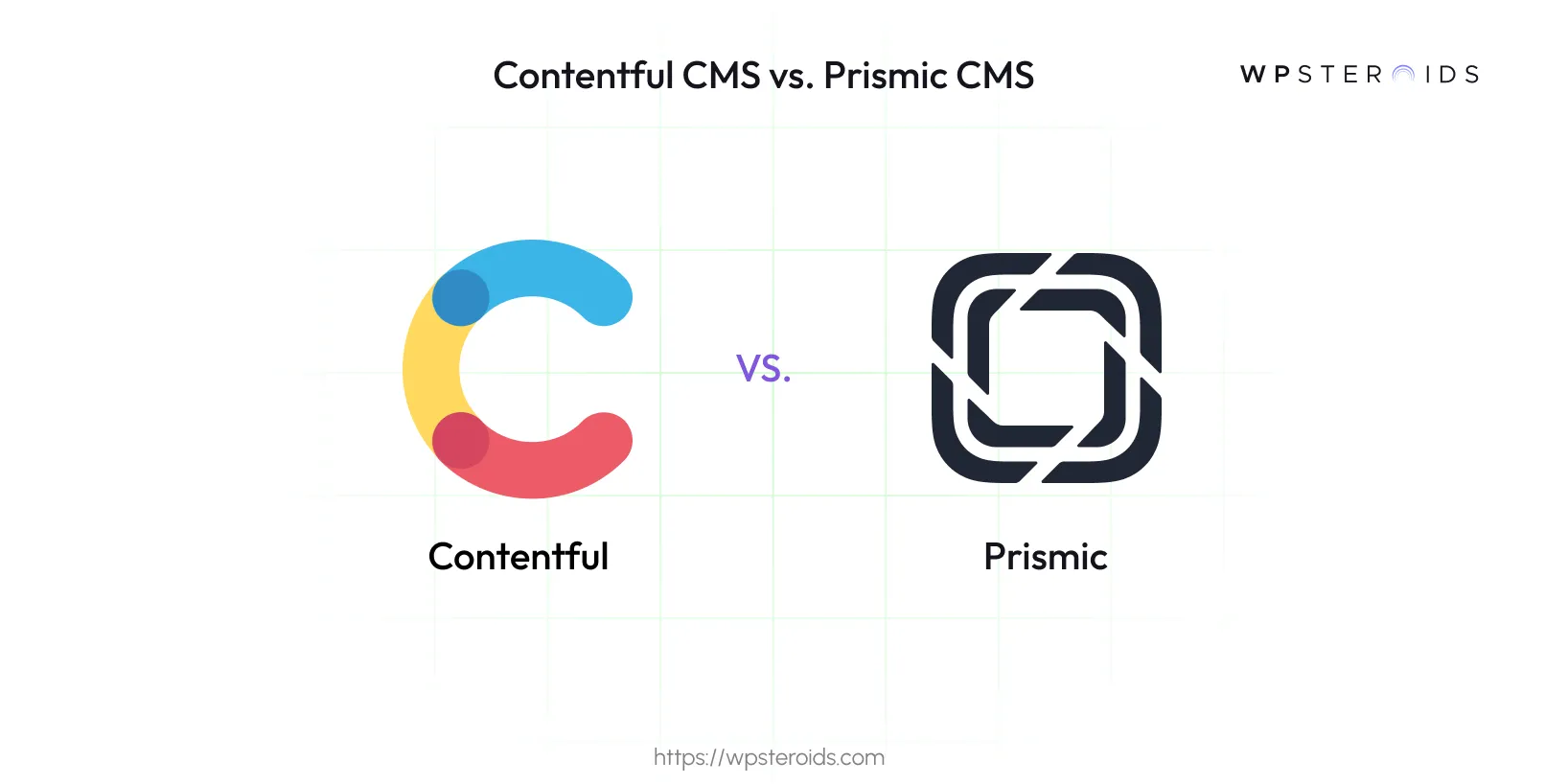
They are both leaders in the headless CMS space, but your choice will ultimately come down to which philosophy best aligns with your project's scope, your team's structure, and how you envision your content operations evolving over time.
Of course. Here is a comprehensive comparison table summarizing the key differences between Prismic and Contentful based on the factors we've discussed.
| Feature / Factor | Prismic | Contentful |
|---|---|---|
| Primary Use Case | Website-centric. Ideal for marketing websites, blogs, and landing pages where visual page building is a priority. | Omnichannel content platform. Designed to deliver structured content to any channel (websites, mobile apps, IoT, etc.). |
| Content Modeling | Component-Driven (Slices): Uses reusable page sections called Slices. Offers great flexibility at the page level. | Structured Data-Driven: Uses highly structured and customizable "Content Types" for granular content elements. Ideal for complex, relational content. |
| Ease of Use (Marketers) | High. The visual page builder with a live preview is very intuitive and requires minimal training for non-technical users. | Moderate. The user interface is clean but form-based, requiring users to understand the content architecture. Has a steeper learning curve. |
| Developer Experience | Fast Onboarding. Offers dedicated SDKs and a local Slice Machine tool that streamlines the setup for modern web frameworks. | Highly Flexible. API-first approach with robust REST and GraphQL APIs gives developers maximum control. Requires more upfront architectural planning. |
| Team Management | Basic Roles: Provides predefined user roles (Writer, Publisher) suitable for smaller, agile teams. | Custom Roles & Permissions: Offers granular, fully customizable user roles and permissions, essential for large, complex organizations. |
| Workflow | Simple: Offers a straightforward draft, review, and publish process. Features "Releases" to bundle and schedule content updates. | Customizable: Allows for multi-step, customizable workflows (e.g., Draft > Legal Review > Publish) to match complex enterprise processes. |
| Integrations | Focused Ecosystem: Provides essential integrations for common web development tools and platforms. Has a smaller, more focused marketplace. | Vast Ecosystem: Features a large marketplace and a robust App Framework for building custom integrations directly into the CMS UI. |
| Security & Compliance | Standard Security: Covers all essential security features needed for most modern businesses. | Enterprise-Grade: Offers advanced features like SOC 2 compliance, custom SSO, and detailed audit trails required by large corporations. |
| Pricing Philosophy | Accessible: Generally more cost-effective with a generous free tier, making it ideal for individuals and SMBs. | Enterprise-Focused: Higher price point on paid plans, but includes more enterprise features out-of-the-box. The free tier is better for proofs of concept. |
| Best Fit For | Teams that prioritize speed-to-market and a highly visual editing experience for building websites. | Teams that require a centralized content hub to manage structured content for multiple channels at enterprise scale. |
Prismic is designed from the ground up with a clear and focused mission: to make building and managing high-performing websites as intuitive and collaborative as possible.
It is an opinionated platform, and its opinion is that the traditional gap between developers and marketers is a major bottleneck.
Prismic's entire feature set is engineered to bridge that gap by providing tools that empower both teams. This website-centric focus is its greatest strength.
At the heart of Prismic's philosophy is the Slice Machine. This is far more than just a component library; it's a shared workspace where developers define reusable website sections (the "Slices") and marketers use them to build pages.
A developer might create Slices for a hero banner, a testimonial slider, and a featured services block.
Marketers can then access these Slices in a visual, drag-and-drop page builder to assemble new pages on the fly, complete with live previews that show them exactly how their content will look.
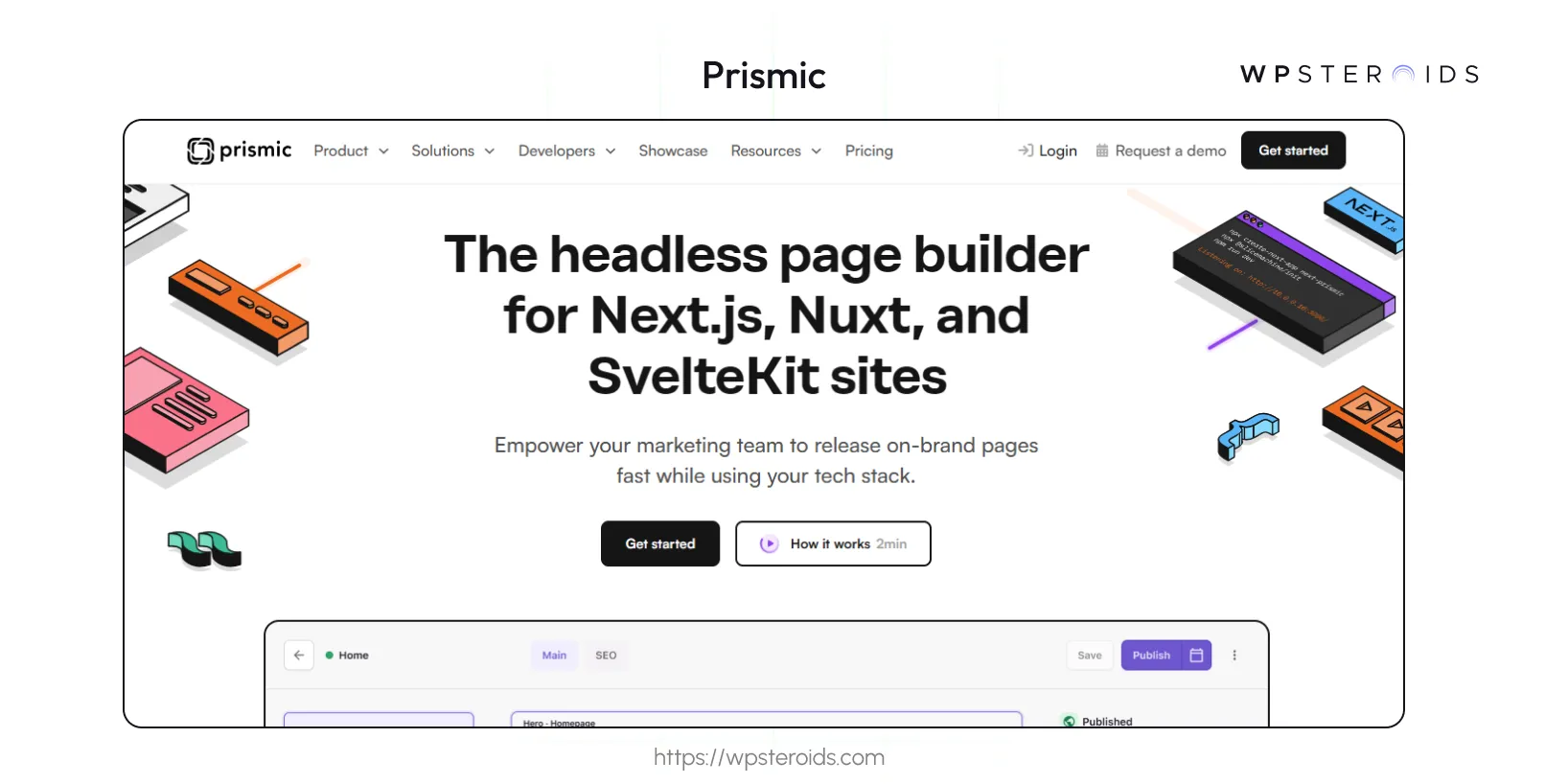
This provides marketers with significant creative autonomy while ensuring they operate within the stylish, on-brand "guardrails" established by the development team.
These aren't just simple API wrappers; they reduce boilerplate code and come with a local development tool that simulates the CMS, allowing developers to build and test Slices locally without constantly pushing changes.
This streamlined process results in a faster onboarding and development cycle. For these reasons, Prismic is the ideal choice for teams whose primary mission is to create and manage marketing websites, blogs, and landing pages, especially when speed-to-market and an excellent visual editing experience are the top priorities.
Contentful operates from a broader, more architectural perspective. It positions itself not merely as a CMS but as a flexible, API-first content platform.
Its core philosophy is to be "use-case agnostic," treating content as a structured, centralized asset that can be seamlessly delivered to any destination.
The primary strength of this model is its incredible flexibility to power an entire ecosystem of digital products from a single source of truth.
To achieve this level of flexibility, Contentful places immense importance on Structured Content Modeling. Instead of focusing on "pages," your team builds a detailed architecture of "Content Types."
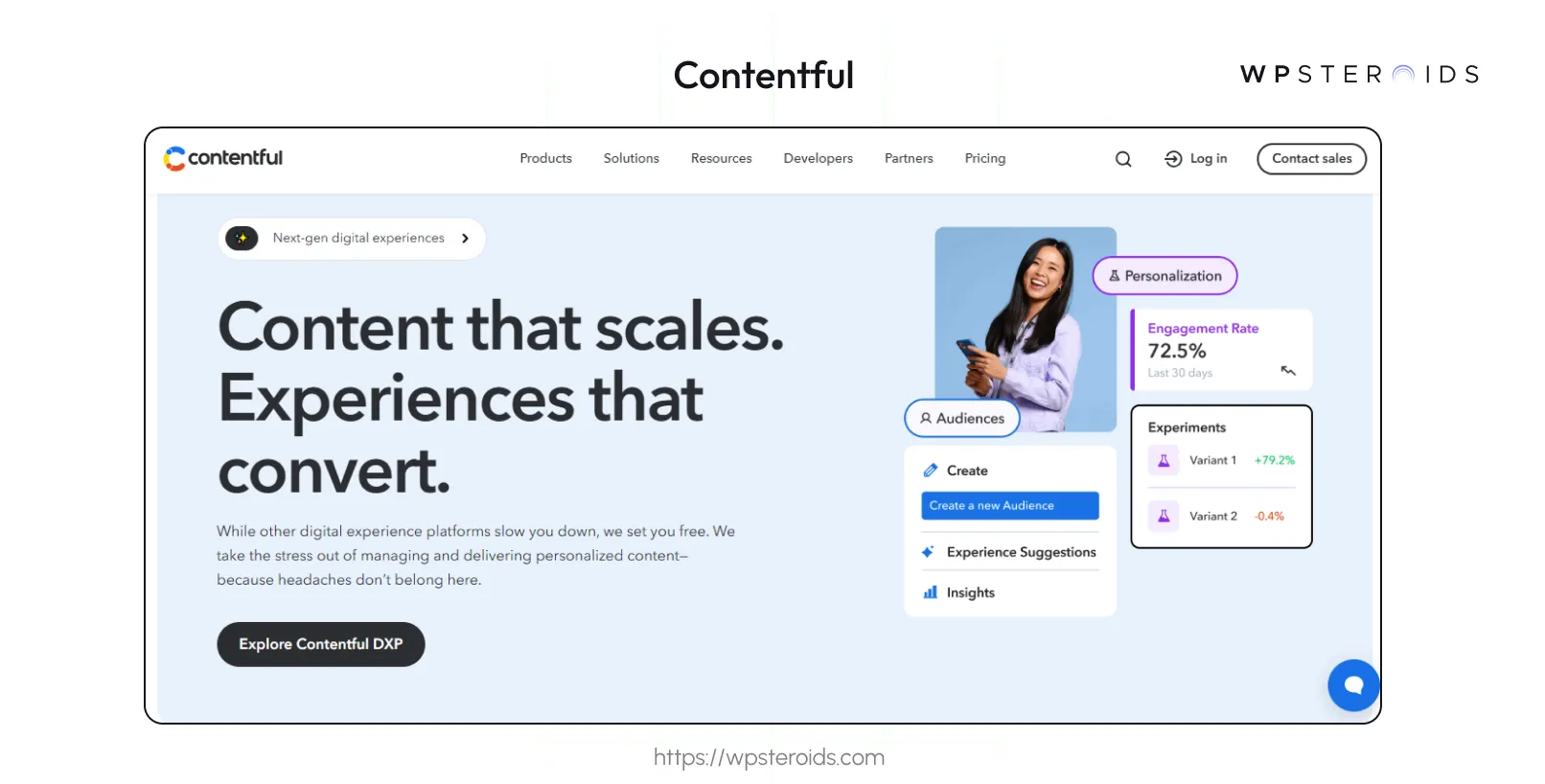
A Content Type is a blueprint for a piece of content, defined by custom fields, data types, and specific validation rules.
For example, instead of a generic "page," you might create separate Content Types for an "Article," a "Webinar," a "Case Study," and an "Author." You can then link these types together (e.g., an "Article" links to its "Author").
This highly structured, form-based approach requires more upfront planning but ensures that your content is perfectly clean, predictable, and consistent at scale.
This structure is designed to be consumed via a powerful API-First foundation. Contentful provides developers with both REST and GraphQL APIs to fetch content, giving them complete control.
The GraphQL API, in particular, is highly efficient for complex queries, allowing an application to retrieve all the nested data it needs in a single request. This makes Contentful exceptionally well-suited for complex, large-scale projects.
Its ideal use cases include global B2B websites that require multi-language support, e-commerce platforms syndicating product data across various frontends, and enterprises managing content across a suite of digital products like a website, a mobile app, and a customer portal simultaneously.
A list of features on a pricing page can only tell you so much. To truly understand how Prismic or Contentful will impact your organization, we need to analyze the day-to-day experience of the people who will be using it the most: your developers and marketers.
This is where the core philosophies we just discussed translate into tangible, daily workflows.
Imagine the marketing team needs a new landing page for an upcoming product launch. They need a hero section, a list of key features, and a testimonial block. Here’s how that process would likely unfold in each CMS.
The Prismic process is designed around speed and visual collaboration, closely mirroring how modern web pages are built with components.
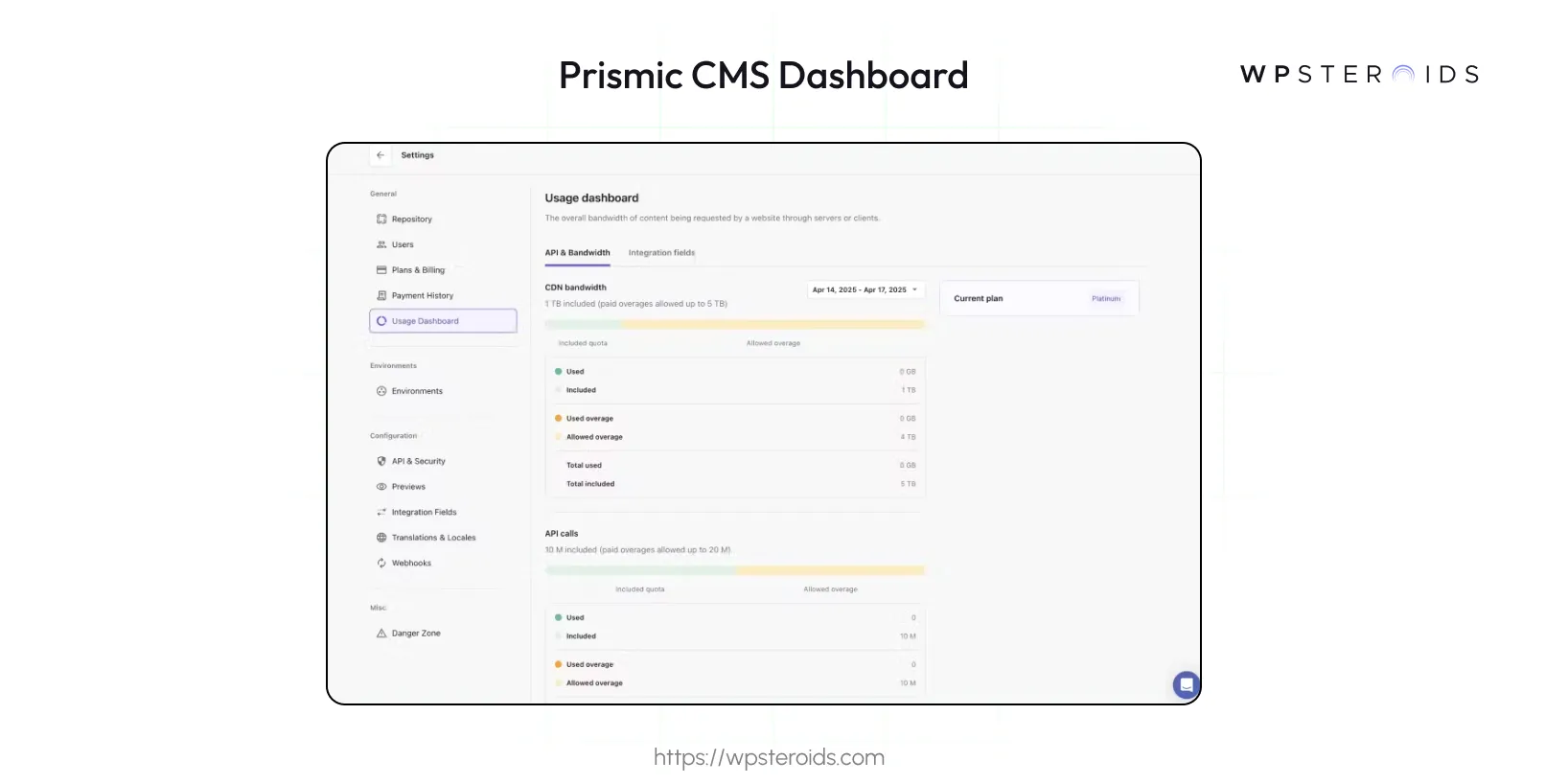
The Contentful process is more architectural, emphasizing structure and planning to ensure content is reusable and consistent everywhere.
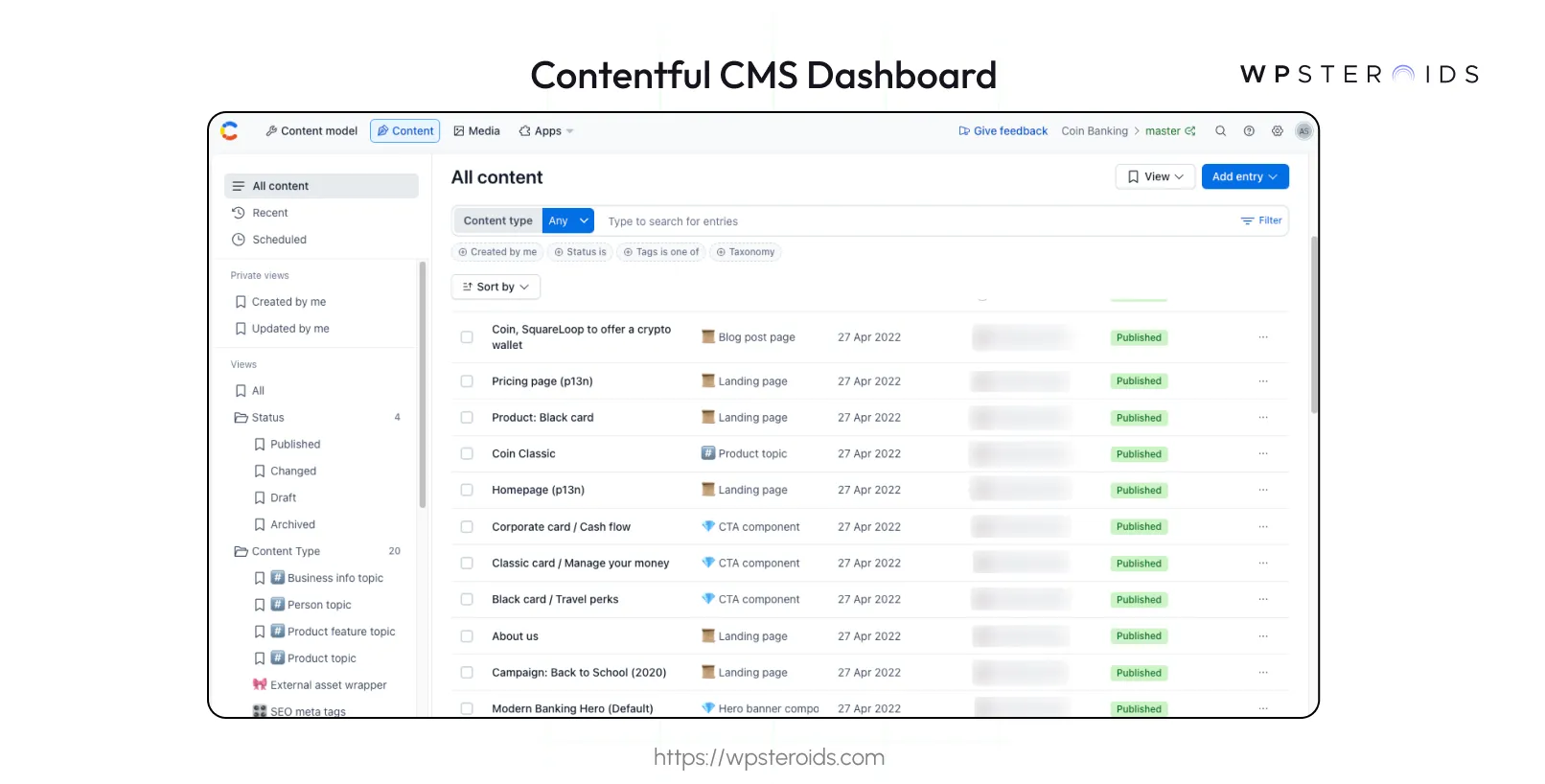
Now that we understand the core philosophies and have seen the day-to-day workflows, let's put the key features of each platform head-to-head.
How your team experiences the platform will be directly tied to how each one approaches content modeling, ease of use, and the ability to integrate with the other tools in your technology stack.
How a CMS allows you to structure your content is arguably its most important feature. This is where Prismic and Contentful show their most significant differences.
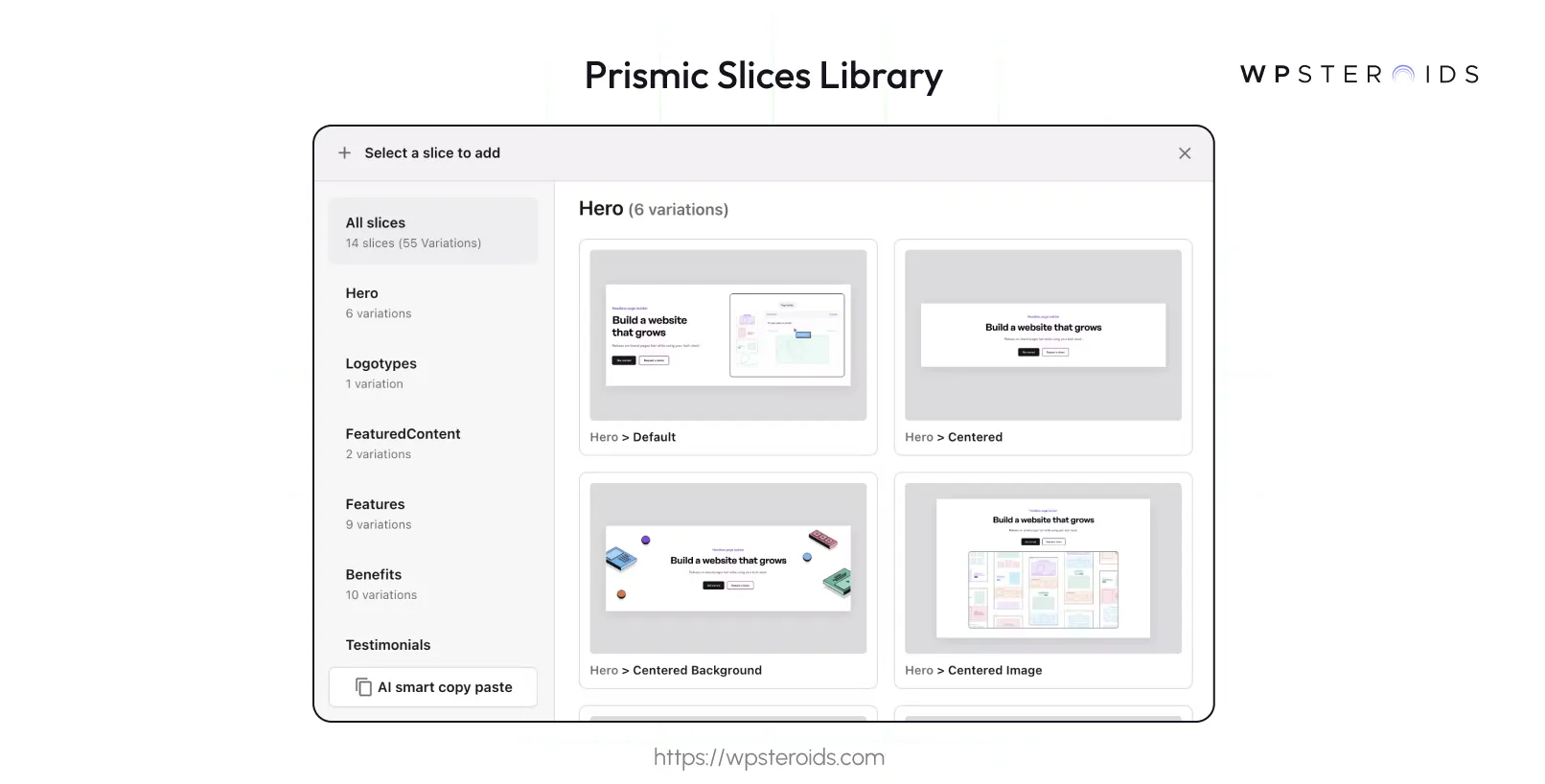

If your marketers and editors can't use the CMS efficiently, the project is at risk. This is an area where user experience differs dramatically between the two platforms.
No CMS exists in a vacuum. Its ability to connect to other services is critical for building a modern digital platform.
When comparing platforms like Prismic and Contentful, it’s tempting to look at their pricing pages and make a quick decision. However, the monthly subscription fee is only one part of the equation.
To understand the true financial impact of choosing a CMS, we need to analyze the Total Cost of Ownership (TCO). This includes not only the subscription cost but also associated expenses like developer hours, scaling, and team training.
The subscription plans for Prismic and Contentful are structured to serve very different scales of operation, which directly reflects their core philosophies.
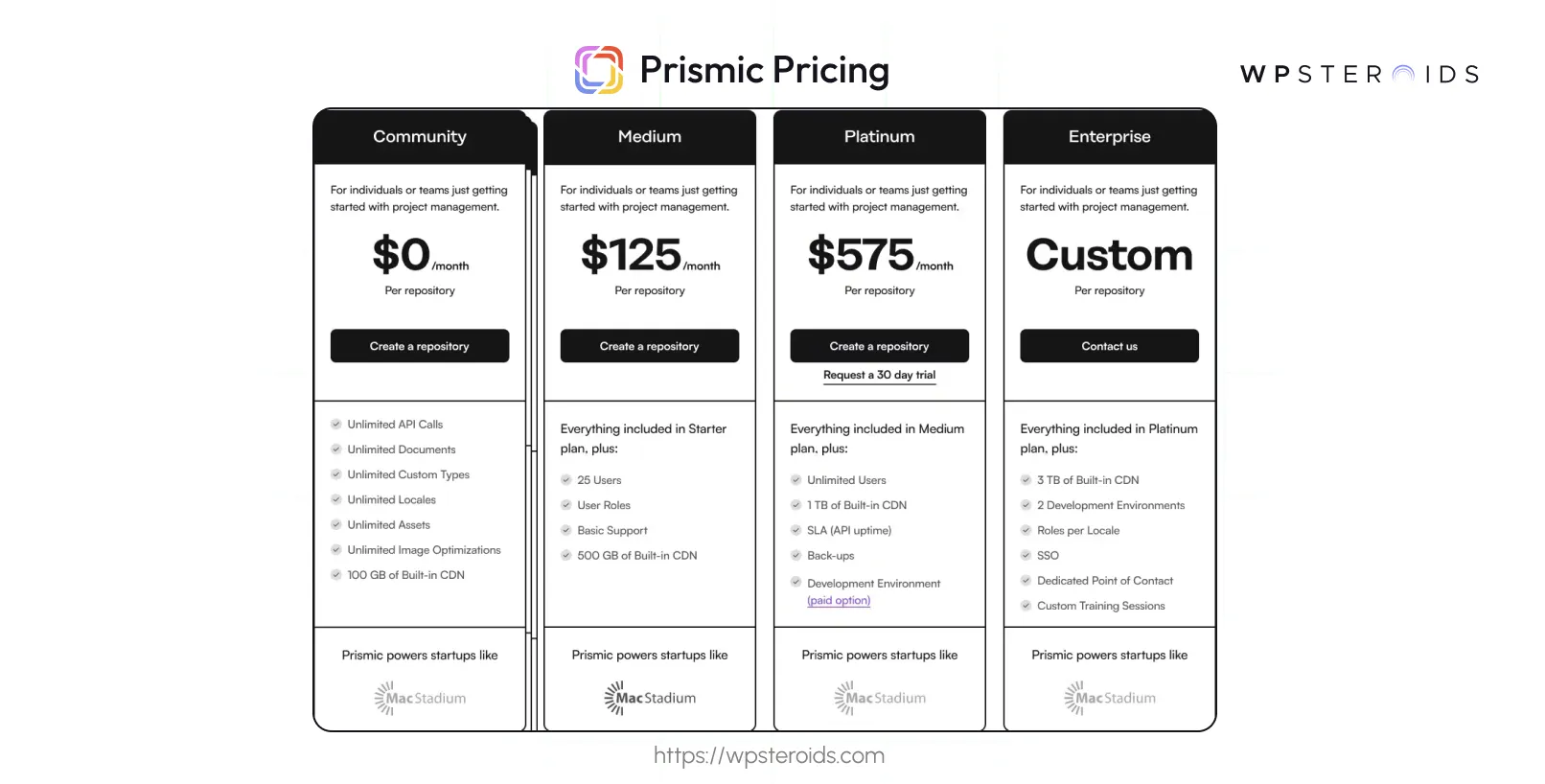

This is where the true cost of ownership becomes clearer. Beyond the monthly bill, you must factor in the time and resources required to build, scale, and maintain your project on each platform.
For small projects, almost any CMS will do. But as your organization grows, the demands you place on your content platform will multiply.
You'll need to think about how you manage a growing team, how you protect sensitive data, and whether your chosen platform can scale with your ambitions.
As your content team grows from a few people to a global department, how you manage their permissions and review their work becomes critical.
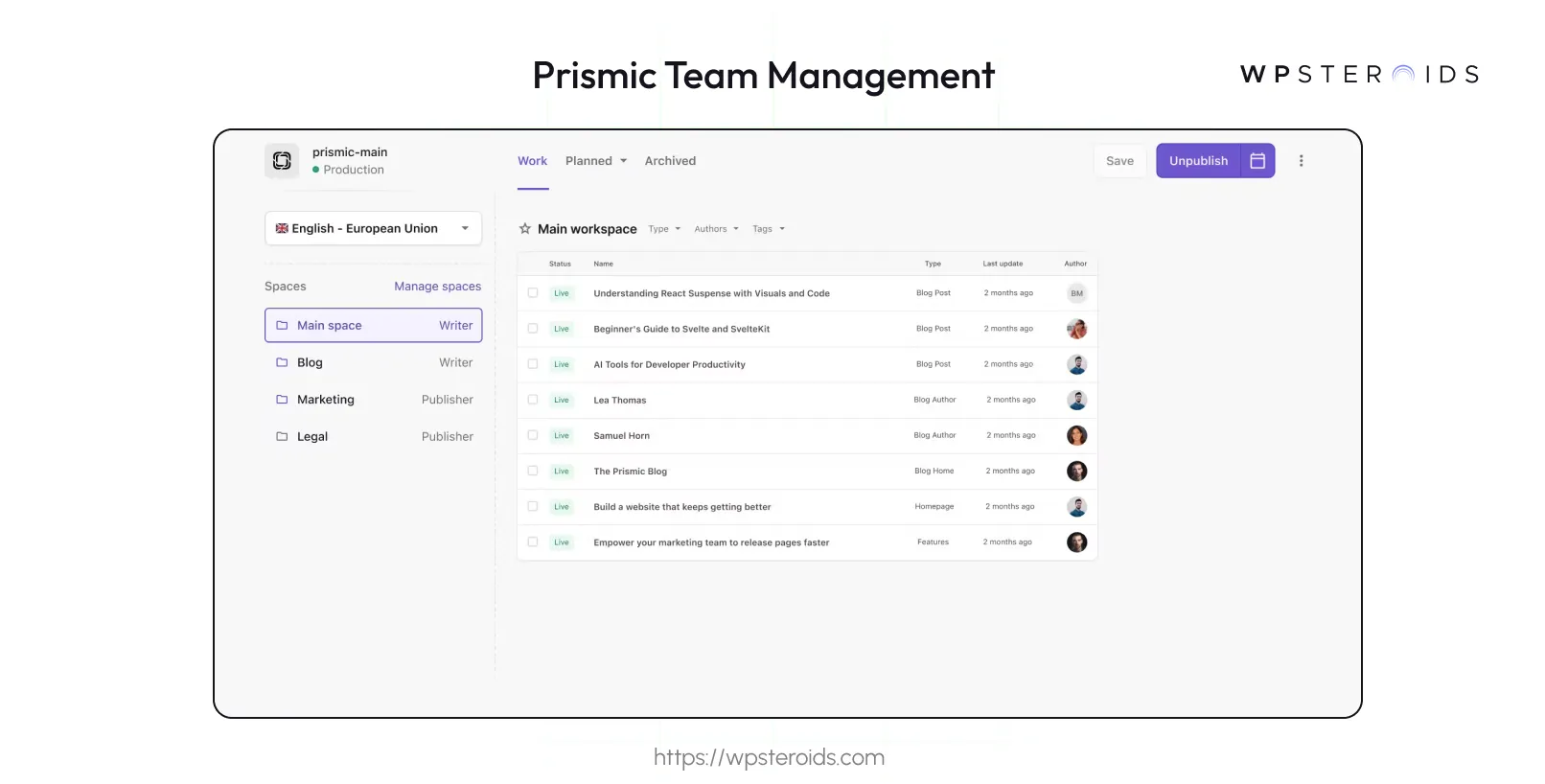
This platform provides the essential tools for managing a small to medium-sized team effectively. It offers a set of predefined user roles (like Writer, Publisher, and Administrator) to control who can create and publish content.
Prismic also includes a "Releases" feature, which allows teams to bundle a group of content changes together and publish them all at once at a scheduled time.
This is perfect for coordinating a new product launch or a marketing campaign on the website. The workflow is simple and effective: draft, review, and publish.
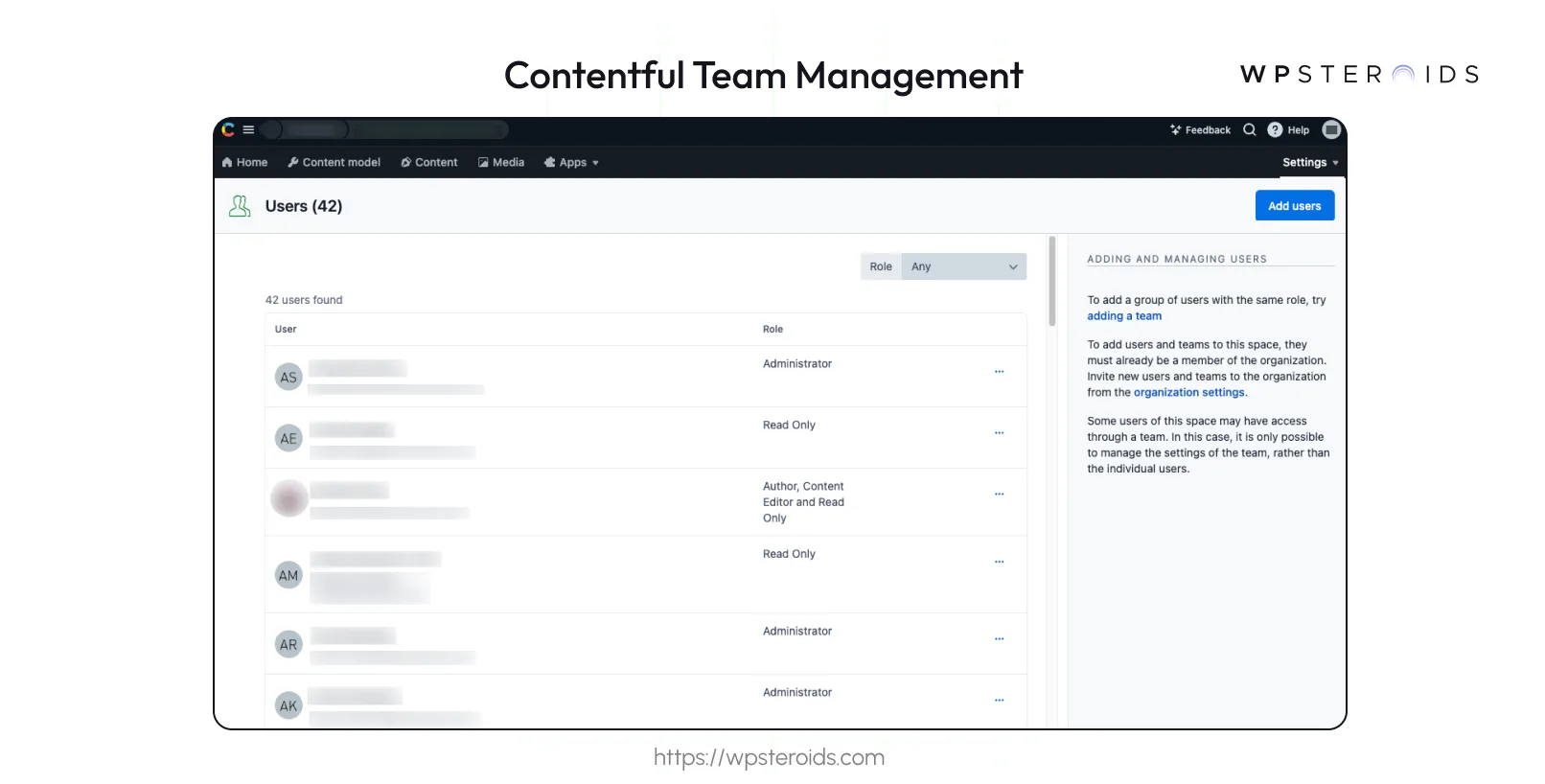
This is where Contentful's enterprise focus becomes unmistakable. It goes far beyond basic roles by offering fully customizable user roles and permissions.
You can create a role for a "Legal Reviewer" who can only view and comment on specific content types, or a "German Translator" who only has access to edit the German language version of your content.
Furthermore, Contentful allows you to build custom, multi-step workflows. A new blog post, for example, could be required to move from a "Draft" stage to "Technical Review," then to "Legal Approval," before it can finally be published.
This level of granular control is crucial for large organizations that need to enforce strict editorial processes and maintain compliance across different departments and regions.
For any modern business, security is paramount. For an enterprise, it's non-negotiable. Both platforms take security seriously, but they cater to different levels of corporate requirements.
This is perhaps the most important strategic consideration, as it addresses how your choice will support you as your company evolves. There is no one-size-fits-all answer, and the right path depends on your company's growth trajectory and priorities.
Let's consider a rapidly growing startup. Their immediate priority might be getting their first product and its marketing website to market as quickly as possible. For them, choosing Prismic is a logical decision.
The faster developer onboarding and intuitive editor allow them to launch quickly. For the first few years, this choice serves them well.
However, a tipping point may arrive when they decide to launch a native mobile app and expand into several European markets.

Suddenly, they have a new problem: they need to manage content across both a website and an app, and they need a complex localization workflow.
At this stage, the team may realize that a platform like Contentful, with its channel-agnostic content modeling and advanced workflows, is a better fit for their new, more complex reality.
The company would then need to plan for a migration, which is a significant but necessary undertaking to support the next phase of its growth.
Conversely, let's look at a well-funded, mid-market company that may only be building a website today but has clear ambitions to expand its digital footprint over the next few years.
This company might choose Contentful from day one, even if its capabilities seem like overkill initially.
By doing so, they are making a strategic investment in their content infrastructure. They spend the extra time and resources upfront to create a detailed, structured content model for their website content.
A year later, when the CEO wants to launch an interactive customer portal, the content foundation is already in place.
The data is clean, structured, and ready to be delivered to this new channel with minimal rework. In this scenario, the upfront investment in structure pays off by making future expansion faster, cheaper, and more efficient.
Your decision between Prismic and Contentful is a strategic one, centered entirely on your team's primary goal. If your mission is to empower developers and marketers to rapidly build and manage beautiful websites with an intuitive, visual workflow, Prismic is the clear, purpose-built solution designed for that exact task. It prioritizes speed-to-market and an exceptional editing experience.
However, if your challenge is more architectural—if you need to manage structured content as a core business asset and deliver it seamlessly to a website, a mobile app, and future channels at enterprise scale—then Contentful provides the robust, flexible foundation required for that long-term vision.
The right choice is the one that best fits your workflow, whether your priority is immediate speed or architectural scale.
